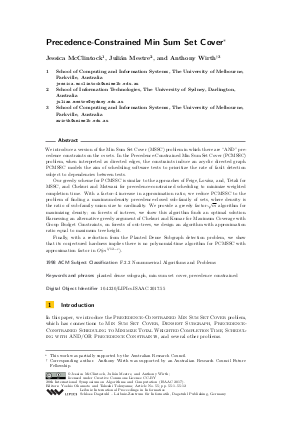Precedence-Constrained Min Sum Set Cover
Authors Jessica McClintock, Julián Mestre, Anthony Wirth
-
Part of:
Volume:
28th International Symposium on Algorithms and Computation (ISAAC 2017)
Part of: Series: Leibniz International Proceedings in Informatics (LIPIcs)
Part of: Conference: International Symposium on Algorithms and Computation (ISAAC) - License:
 Creative Commons Attribution 3.0 Unported license
Creative Commons Attribution 3.0 Unported license
- Publication Date: 2017-12-07
File

PDF
LIPIcs.ISAAC.2017.55.pdf
- Filesize: 0.51 MB
- 12 pages
Document Identifiers
Subject Classification
Keywords
- planted dense subgraph
- min sum set cover
- precedence constrained
Metrics
- Access Statistics
-
Total Accesses (updated on a weekly basis)
0PDF Downloads0Metadata Views
Abstract
We introduce a version of the Min Sum Set Cover (MSSC) problem in which there are "AND" precedence constraints on the m sets. In the Precedence-Constrained Min Sum Set Cover (PCMSSC) problem, when interpreted as directed edges, the constraints induce an acyclic directed graph. PCMSSC models the aim of scheduling software tests to prioritize the rate of fault detection subject to dependencies between tests.
Our greedy scheme for PCMSSC is similar to the approaches of Feige, Lovasz, and, Tetali for MSSC, and Chekuri and Motwani for precedence-constrained scheduling to minimize weighted completion time. With a factor-4 increase in approximation ratio, we reduce PCMSSC to the problem of
finding a maximum-density precedence-closed sub-family of sets, where density is the ratio of sub-family union size to cardinality. We provide a greedy factor-sqrt m algorithm for maximizing density; on forests of in-trees, we show this algorithm finds an optimal solution. Harnessing an alternative greedy argument of Chekuri and Kumar for Maximum Coverage with Group Budget Constraints, on forests of out-trees, we design an algorithm with approximation ratio equal to maximum tree height.
Finally, with a reduction from the Planted Dense Subgraph detection problem, we show that its conjectured hardness implies there is no polynomial-time algorithm for PCMSSC with approximation factor in O(m^{1/12-epsilon}).
Cite As Get BibTex
Jessica McClintock, Julián Mestre, and Anthony Wirth. Precedence-Constrained Min Sum Set Cover. In 28th International Symposium on Algorithms and Computation (ISAAC 2017). Leibniz International Proceedings in Informatics (LIPIcs), Volume 92, pp. 55:1-55:12, Schloss Dagstuhl – Leibniz-Zentrum für Informatik (2017)
https://doi.org/10.4230/LIPIcs.ISAAC.2017.55
BibTex
@InProceedings{mcclintock_et_al:LIPIcs.ISAAC.2017.55,
author = {McClintock, Jessica and Mestre, Juli\'{a}n and Wirth, Anthony},
title = {{Precedence-Constrained Min Sum Set Cover}},
booktitle = {28th International Symposium on Algorithms and Computation (ISAAC 2017)},
pages = {55:1--55:12},
series = {Leibniz International Proceedings in Informatics (LIPIcs)},
ISBN = {978-3-95977-054-5},
ISSN = {1868-8969},
year = {2017},
volume = {92},
editor = {Okamoto, Yoshio and Tokuyama, Takeshi},
publisher = {Schloss Dagstuhl -- Leibniz-Zentrum f{\"u}r Informatik},
address = {Dagstuhl, Germany},
URL = {https://drops.dagstuhl.de/entities/document/10.4230/LIPIcs.ISAAC.2017.55},
URN = {urn:nbn:de:0030-drops-82648},
doi = {10.4230/LIPIcs.ISAAC.2017.55},
annote = {Keywords: planted dense subgraph, min sum set cover, precedence constrained}
}
Author Details
References
-
Yossi Azar, Iftah Gamzu, and Xiaoxin Yin. Multiple intents re-ranking. In STOC: 41st ACM Symposium on Theory of Computing, pages 669-678, 2009.

-
Nikhil Bansal, Anupam Gupta, and Ravishankar Krishnaswamy. A constant factor approximation algorithm for generalized min-sum set cover. In SODA: 21st ACM-SIAM Symposium on Discrete Algorithms, pages 1539-1545, 2010.

-
Glencora Borradaile, Brent Heeringa, and Gordon Wilfong. The knapsack problem with neighbour constraints. Journal of Discrete Algorithms, 16:224-235, 2012.

-
Jen Burge, Kamesh Munagala, and Utkarsh Srivastava. Ordering pipelined query operators with precedence constraints. Technical Report 2005-40, Stanford InfoLab, 2005.

-
Moses Charikar, Yonatan Naamad, and Anthony Wirth. On approximating target set selection. In APPROX: 19th International Workshop on Approximation Algorithms for Combinatorial Optimization Problems, pages 4:1-4:16, 2016.

-
Chandra Chekuri and Amit Kumar. Maximum coverage problem with group budget constraints and applications. In APPROX: 7th International Workshop on Approximation Algorithms for Combinatorial Optimization Problems, pages 72-83, 2004.

-
Chandra Chekuri and Rajeev Motwani. Precedence constrained scheduling to minimize sum of weighted completion times on a single machine. Discrete Applied Mathematics, 98(1):29-38, 1999.

-
Irit Dinur and Shmuel Safra. On the hardness of approximating label-cover. Information Processing Letters, 89(5):247-254, 2004.

-
Thomas Erlebach, Vanessa Kääb, and Rolf H Möhring. Scheduling AND/OR-networks on identical parallel machines. In WOAO: International Workshop on Approximation and Online Algorithms, pages 123-136, 2003.

-
Uriel Feige, László Lovász, and Prasad Tetali. Approximating min sum set cover. Algorithmica, 40(4):219-234, 2004.

-
Donald W. Gillies and Jane W.-S. Liu. Scheduling tasks with and/or precedence constraints. SIAM Journal on Computing, 24(4):797-810, 1995.

-
A. V. Goldberg. Finding a maximum density subgraph. Technical Report CSD-84-171, UC Berkeley Computer Science Division, 1984.

-
Michael Goldwasser and Rajeev Motwani. Intractability of assembly sequencing: Unit disks in the plane. In WADS: Workshop on Algorithms and Data Structures, pages 307-320, 1997.

-
M Hajiaghayi, Kamal Jain, L Lau, I Măndoiu, Alexander Russell, and V Vazirani. Minimum multicolored subgraph problem in multiplex pcr primer set selection and population haplotyping. Computational Science-ICCS 2006, pages 758-766, 2006.

-
David S. Johnson and K. A. Niemi. On knapsacks, partitions, and a new dynamic programming technique for trees. Mathematics of Operations Research, 8(1):1-14, 1983.

-
Stavros G. Kolliopoulos and George Steiner. Partially ordered knapsack and applications to scheduling. Discrete Applied Mathematics, 155(8):889-897, 2007.

-
Jesssica McClintock, Tim Miller, and Anthony Wirth. Prioritisation of test suites containing precedence constraints, 2017. submitted.

-
Tim Miller and Shifa-e-Zehra Haidry. Using dependency structures for prioritization of functional test suites. IEEE Transactions on Software Engineering, 39(2):258-275, 2013.

-
Kamesh Munagala, Shivnath Babu, Rajeev Motwani, and Jennifer Widom. The pipelined set cover problem. In ICDT: 10th International Conference on Database Theory, pages 83-98, 2005.

